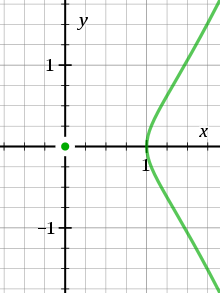Acnode

An acnode is an isolated point not on a curve, but whose coordinates satisfy the equation of the curve. The term "isolated point" or "hermit point" is an equivalent term.[1]
Acnodes are commonly found in the study of algebraic curves over fields which are not algebraically closed, defined as the zero set of a polynomial of two variables. For example the equation
has an acnode at the origin of  , because it is equivalent to
, because it is equivalent to
and  is non-negative when
is non-negative when  ≥ 1 and when
≥ 1 and when  . Thus, over the real numbers the equation has no solutions for
. Thus, over the real numbers the equation has no solutions for  except for (0, 0).
except for (0, 0).
In contrast, over the complex numbers the origin is not isolated since square roots of negative real numbers exist.
An acnode is a singularity of the function, where both partial derivatives  and
and  vanish. Further the Hessian matrix of second derivatives will be positive definite or negative definite. Hence the function has a local minimum or a local maximum.
vanish. Further the Hessian matrix of second derivatives will be positive definite or negative definite. Hence the function has a local minimum or a local maximum.
See also
References
- ↑ Hazewinkel, M. (2001), "Acnode", in Hazewinkel, Michiel, Encyclopedia of Mathematics, Springer, ISBN 978-1-55608-010-4
- Porteous, Ian (1994). Geometric Differentation. Cambridge University Press. ISBN 0-521-39063-X.
| ||||||||||||||||||||||||||||||||||||||||||||||||||||||||||

